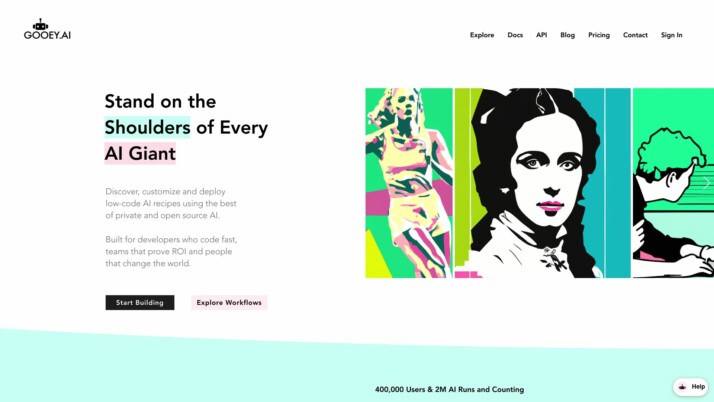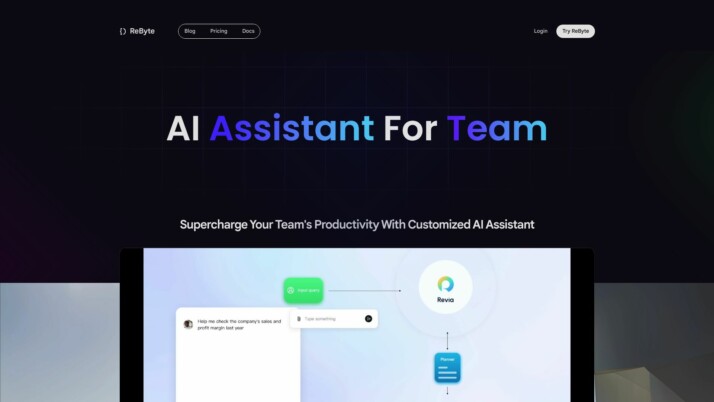Gooey AI vs. Rebyte: Comparing AI Agent Platforms
AI-powered solutions have become indispensable for businesses seeking to streamline operations and enhance productivity. This review compares three leading platforms in the AI agent development space: Gooey AI vs. Rebyte, and SmythOS. We’ll explore their unique features, strengths, and limitations to help you choose the right tool for your AI development needs. Whether you’re a seasoned developer, a business leader, or an AI enthusiast, this comparison will provide valuable insights into each platform’s capabilities, from visual builders and integrations to deployment options and scalability. By the end, you’ll have a clear understanding of how these platforms stack up and which one might best suit your specific requirements in the ever-evolving world of AI automation.
Gooey AI Overview
Gooey AI empowers users to create sophisticated AI copilots and chatbots without extensive coding knowledge. The platform integrates multiple large language models, including GPT-3.5, GPT-4, and Google’s PaLM2, to deliver advanced conversational capabilities.
Gooey AI’s no-code interface simplifies the development of AI solutions, making it accessible to both technical and non-technical users. The platform excels in document processing, offering features like OCR, vision capabilities, and integrations with popular communication tools such as Facebook, Slack, and WhatsApp.


Gooey AI empowers users to create sophisticated AI copilots and chatbots without extensive coding knowledge.
Key strengths include Retrieval Augmented Generation (RAG) for accurate information retrieval, synthetic data extraction for enhanced search results, and advanced speech recognition and translation capabilities. These features enable users to build AI copilots that maintain context, provide relevant responses, and operate across multiple languages.
Gooey AI supports autonomous agents capable of performing tasks and making decisions based on predefined rules. The platform also facilitates multi-agent collaboration, allowing teams to work together on AI projects efficiently. While Gooey AI offers robust capabilities, it may lack some advanced features like a dedicated debug mode or specialized IP control options.
For businesses and developers seeking to leverage AI for productivity and knowledge management, Gooey AI presents a compelling solution. Its focus on combining private and open-source AI technologies aims to democratize AI development across various industries, from agriculture to customer support.
Rebyte Overview
Rebyte empowers users to rapidly build AI-powered applications without extensive coding skills. The platform’s visual agent builder enables the creation of customizable AI agents with multi-step workflows using large language models. Users can design complex backend logic and fully customized user interfaces without writing code.


Rebyte empowers users to rapidly build AI-powered applications without extensive coding skills.
Rebyte’s serverless runtime handles hosting, orchestration, testing, and deployment of AI agen
ts. This comprehensive approach manages the entire lifecycle of AI applications, from development to production. The platform integrates with private data sources and provides detailed observability into each step of an agent’s process.
Key differentiators include Rebyte’s focus on end-user programming through AI and its ability to streamline the journey from concept to deployed application. The platform’s no-code UI for building AI copilots and workflows makes it accessible to non-technical users, while still offering powerful capabilities for developers.
Rebyte supports a wide range of AI functionalities, including context maintenance, memory capabilities, and multimodal inputs and outputs. The platform enables the creation of autonomous agents that can perform tasks and make decisions based on predefined rules. Additionally, Rebyte facilitates multi-agent collaboration, allowing multiple AI agents to work together on complex projects.
While Rebyte offers numerous advantages, it’s important to note that some advanced features like a dedicated debug mode or integration with specific tools like Hugging Face models are not explicitly mentioned. However, the platform’s focus on accessibility, scalability, and comprehensive AI development capabilities positions it as a strong contender in the AI agent builder market.
Feature Comparison
Gooey AI and Rebyte offer powerful platforms for building AI agents, but key differences emerge in their feature sets. Gooey AI excels in document processing with OCR capabilities and integrations with popular communication tools like Facebook and WhatsApp. It also provides advanced speech recognition and translation features. However, Gooey AI lacks a dedicated visual builder for creating AI workflows.
Rebyte, on the other hand, emphasizes its visual agent builder that allows users to create multi-step workflows without coding. This makes Rebyte more accessible for non-technical users looking to build complex AI applications. Rebyte also offers a serverless runtime for hosting and deploying agents, streamlining the development to production process.
In terms of core components, both platforms support various AI models and APIs, but Gooey AI has a slight edge with explicit mentions of integration with models like GPT-4 and Google’s PaLM2. Rebyte’s documentation doesn’t specify which AI models it supports, potentially limiting options for users requiring specific AI capabilities.
Security features represent another area of differentiation. While both platforms likely implement standard security practices, Rebyte emphasizes its detailed observability into agent processes, potentially offering greater transparency and control. Gooey AI’s security features are less prominently highlighted, which may be a concern for enterprises with strict security requirements.
Overall, Gooey AI appears stronger in specific AI capabilities like speech recognition and document processing, while Rebyte offers a more accessible development experience with its visual builder and comprehensive deployment options. The choice between them would depend on the user’s technical expertise and specific AI application needs.
Feature Comparison Table
| Gooey AI | Rebyte | SmythOS | |
|---|---|---|---|
| CORE FEATURES | |||
| Autonomous Agents | ✅ | ❌ | ✅ |
| Multimodal | ✅ | ❌ | ✅ |
| Multi-Agent Collaboration | ✅ | ❌ | ✅ |
| SECURITY | |||
| Constrained Alignment | ✅ | ❌ | ✅ |
| Data Encryption | ✅ | ❌ | ✅ |
| OAuth | ✅ | ❌ | ✅ |
| IP Control | ❌ | ❌ | ✅ |
| COMPONENTS | |||
| Huggingface AIs | ✅ | ❌ | ✅ |
| Zapier APIs | ❌ | ✅ | ✅ |
| Classifiers | ✅ | ❌ | ✅ |
| Logic | ✅ | ❌ | ✅ |
| Data Lakes | ❌ | ❌ | ✅ |
| DEPLOYMENT OPTIONS (EMBODIMENTS) | |||
| Deploy as Webhook | ✅ | ❌ | ✅ |
| Staging Domains | ❌ | ❌ | ✅ |
| Production Domains | ❌ | ❌ | ✅ |
| API Authentication (OAuth + Key) | ✅ | ❌ | ✅ |
| Deploy as Scheduled Agent | ✅ | ❌ | ✅ |
| DATA LAKE SUPPORT | |||
| Sitemap Crawler | ❌ | ❌ | ✅ |
| YouTube Transcript Crawler | ✅ | ❌ | ✅ |
| URL Crawler | ✅ | ❌ | ✅ |
Best Alternative to Gooey AI and Rebyte
SmythOS stands out as the superior alternative to Gooey AI and Rebyte for AI agent development and deployment. Our platform combines powerful features with unmatched ease of use, empowering users to create sophisticated AI solutions for unlimited use cases.
We offer a comprehensive visual builder that surpasses both competitors. Unlike Gooey AI’s lack of a dedicated visual workflow creator, our drag-and-drop interface allows users to design complex AI agents without coding. While Rebyte provides a visual builder, ours offers more advanced capabilities for crafting intricate, multi-step workflows.
Unlike Gooey AI’s lack of a dedicated visual workflow creator, our drag-and-drop interface allows users to design complex AI agents without coding.
Our platform excels in versatility and integration. We support a wide array of AI models, including those from OpenAI, Anthropic, and Hugging Face, providing users with unparalleled flexibility. This extensive model support, coupled with our pre-built API integrations, allows for the creation of highly customized AI solutions that seamlessly fit into existing business processes.
Security and scalability set SmythOS apart. We implement robust security measures, including data encryption and OAuth authentication, addressing enterprise-level concerns that Rebyte’s documentation doesn’t explicitly cover. Our platform is designed for scalability, supporting both small-scale projects and large enterprise deployments with equal efficiency.
Unlike our competitors, SmythOS offers a complete ecosystem for AI agent development, deployment, and management. From our hosted vector database for efficient data handling to our support for multimodal interactions, we provide a comprehensive suite of tools that cater to diverse AI applications. This all-in-one approach eliminates the need for multiple platforms or complex integrations, streamlining the entire AI development process.
Conclusion
Gooey AI and Rebyte offer compelling AI agent building platforms, each with unique strengths. Gooey AI excels in document processing and speech recognition, while Rebyte’s visual builder simplifies complex workflow creation. Both platforms empower users to leverage AI without extensive coding skills.
However, SmythOS emerges as the superior choice, combining the best features of both competitors with additional capabilities. Our drag-and-drop interface rivals Rebyte’s visual builder, while our extensive API integrations and support for various AI models surpass Gooey AI’s offerings. SmythOS’s multi-agent orchestration and versatile deployment options provide unparalleled flexibility for businesses of all sizes.
SmythOS stands out with its comprehensive approach to AI agent development and deployment. We offer a robust ecosystem of over 300,000 integrations, allowing users to create sophisticated AI workflows effortlessly. Our ’Create Once, Deploy Anywhere’ philosophy ensures that AI agents built on SmythOS can be easily integrated into multiple environments, from chatbots to APIs.
For those ready to experience the future of AI automation, we invite you to explore our diverse range of AI-powered agent templates. These templates cover multiple business categories and are designed to streamline processes across various functions. To get started with SmythOS and unlock its full potential, create a free account today. With our risk-free trial and generous free plan, you can begin building AI agents immediately and transform your workflow with intelligent automation.
Last updated:
Disclaimer: The information presented in this article is for general informational purposes only and is provided as is. While we strive to keep the content up-to-date and accurate, we make no representations or warranties of any kind, express or implied, about the completeness, accuracy, reliability, suitability, or availability of the information contained in this article.
Any reliance you place on such information is strictly at your own risk. We reserve the right to make additions, deletions, or modifications to the contents of this article at any time without prior notice.
In no event will we be liable for any loss or damage including without limitation, indirect or consequential loss or damage, or any loss or damage whatsoever arising from loss of data, profits, or any other loss not specified herein arising out of, or in connection with, the use of this article.
Despite our best efforts, this article may contain oversights, errors, or omissions. If you notice any inaccuracies or have concerns about the content, please report them through our content feedback form. Your input helps us maintain the quality and reliability of our information.
